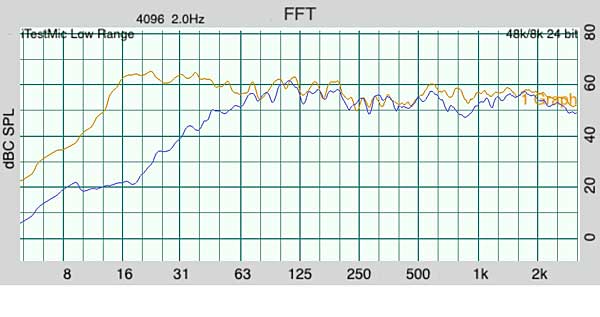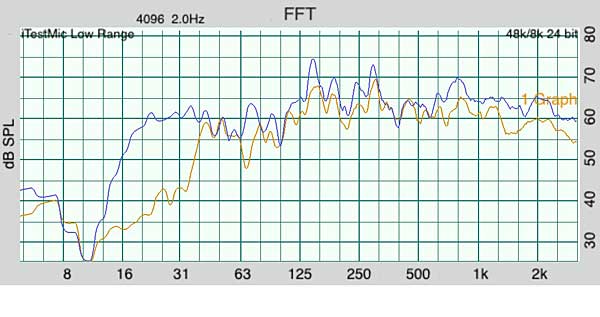| Columns Retired Columns & Blogs |
I am saving my pennies for a pair.
During these tests, the high-pass filter of my JL Audio CR-1 crossover was set to 70Hz, 24dB/octave (Quads) or to 50Hz, 24dB/octave (KEFs). Alternatively, I set the CR-1's high-pass filter down to 20Hz to allow the LS50s to run full range with SB-3000 reinforcement. For all satellite setups, the SB-3000's filter remained at 70Hz, 24dB/octave and its built-in room compensation filter was set to 25Hz, 24dB/octave to reduce room overload.
For all measurements, I used the SPL Meter module of Studio Six Digital's AudioTools (version 10.5.6), A-weighting on, plus that company's iTestMic microphone for the iPhone. I matched the outputs of the satellites and subs by turning off the subs, playing a recording of uncorrelated pink noise, and setting (via my preamp's remote) the satellite's output, run full range, to 75dB SPL at my listening chair. I then turned off the satellite speakers and adjusted (using the SVS subwoofer control app) the sub's output level to –15 so its output on bass peaks was 75dB SPL.
I used AudioTools' Fast Fourier Transform function to measure the in-room response with uncorrelated pink noise by setting it to 1/6 octave, 1-second delay, flat frequency response plot, low frequency range (10Hz–3kHz), no peak tracking, averaging mode, and log frequency scale. I averaged five room responses across a 2' horizontal window at the level of my ears sitting in my listening chair. As before, the in-room response revealed a –7dB null centered around 60Hz, which was reduced when I set both low-pass and high-pass crossover filters to 80Hz. I saw minimal changes in the FFT graphs of the null or in my listening experiences, so all test measurements were done with the specific high-pass filter crossover settings listed above.
Fig.1 shows the in-room response of the Quad ESL-989s run full range, high-pass filter bypassed (blue trace), superimposed on the plot of the Quad 989s plus SB-3000 subs, all filters on and set as described above (orange trace).

Fig.2 shows the in-room response of the KEF LS50s run full range, alone (orange trace), superimposed on the plot of the KEF's full-range output combined with the SB-3000, all filters on (blue trace).

For both the Quads and KEF satellite speakers, the SB-3000 extends their flat frequency response from their normal –3dB rolloff frequency (80Hz and 60Hz, respectively) down to 16Hz, ±3dB. This is an impressively flat, deep bass room response for two 13" subwoofers.—Larry Greenhill

I am saving my pennies for a pair.

If they have 1,000 dealers plus direct sales, they must be doing something(s) right :-) .........

SVS is carried by Best Buy.
Jim Austin, Editor
Stereophile

Well .... That makes sense ........ SVS makes 'Best Buy' products :-) ........

Good value? Stuff that isn't defined by being something other people can't afford?

Dr. John P. Kreskovsky is terminating his website at the end of this month (MusicAndDesign dot com). I am not sure how quickly that will actually go dark, but could be as soon as sometime today. I also have not looked to see if any of it is captured in the internet archive "Wayback Machine".
More to the point, JPK had generously posted some very interesting write-ups of technical studies of his, and those are available right now, and maybe not for much longer. Among them is some very good information on integrating monopole woofers with gradient satellites, room interaction, power response, crossover design, dipole loudspeaker design, etc. ...very worthwhile reading and very relevant to your ESLs.

http://musicanddesign.com/tech.html
edit 04 Sep 2019:
That website no longer exists.

Larry Greehill, if you have problems in the future with your Quad ESL-989 pair (such as glue line separation between the stators and support structure), I suggest contacting Dr. Sheldon D. Stokes, currently in Grantham, NH.
SDS is very intelligent, highly motivated, well educated and well skilled, is very broadly capable, and has a love for the refurbishment and caretaking of Quad ESLs.
You won't find anyone better.

While monopole subwoofers will be useful for the bottom octave or two, I would suggest something more acoustically similar to the gradient planar ESLs in the lower midrange and upper bass.
I would suggest looking for some inexpensive lightly used and fully functional Magnepan Magneplanar Tympani loudspeakers, the ones where each side looks like a three panel room divider.
The panels are 18 inches wide by 72 inches tall, and 2 inches thick. The outer two panels serve as woofers while the center panel handles the remaining upper frequency spectrum.
My suggestion is to use only the woofer panels, mounting a pair of panels to each side wall flanking your ESLs, mounting the side edge of a panel to the wall with some means of adjusting angle, some means of easy removal, and some means of preventing motion of the panel in use.
An 18 inch depth would have 1/4 wave cavity resonance at fundamental frequency of 13560/(18*4)= 188_Hz, and harmonics.
The two panels on each side can be mounted one in front of the other, parallel, and angled to face the listener. Separation distance between panels should be 1/Phi= 62% of the cavity depth to smoothly distribute resonance fundamentals and harmonics.
The panels should be located in the side nulls of the ESLs, which also place the ESLs in the side nulls of the woofer panels.
Whatever the voltage sensitivity is for those panels, sidewall mounting will add +6_dB, and the close coupled pairing will add +6_dB, summing with correlated phase at the frequencies of interest. The panels are resistive in nature, unlike reactive ESLs, and won't be very fussy about amplifiers at the low frequencies involved in powering these as long as the amplifiers exhibit inaudible noise at low power during quiet passages in the music, and adequately low distortion at requisite high power on 0_dBFS signal crests.

I should mention that this is not my idea, and is not a new idea. People have been marrying Magnepan Magneplanar Tympani woofer panel with various Quad ESL loudspeakers for a long while, utilizing the two different technologies to best advantage.
An alternative to the older used Tympani bass panels could be to use Magnepan DWM bass panels, available new. But since these are smaller you might need more of them, and might need to get more creative in the array, wall mounting, etc.

If, somebody can convince Magnepan to sell, just the bass panels of their new model 30.7, those bass panels may work well with the new Quad ESL electrostatics ........ Also, those Magnepan 30.7 bass panels may work well with the new Martin Logan CLX Art electrostatics :-) .........

Those Magnepan DWM bass panels may work well with their own new LRS speakers (reviewed in Stereophile) :-) .......

Is the LRS worth the bother?

It was just a suggestion for those who are interested in buying the LRS ......... Seemed like there were several, who were interested in buying the LRS in the Stereophile website forum :-) .........

Vintage Acoustat 2+2's used only as woofers do a decent job, as well.

They are taller than Shaq :-) .........

Larry Greenhill, though I expect that you have seen this more than once, please take another look, as it applies well to your setup.
https://www.harman.com/sites/default/files/multsubs_0.pdf
In the file above, see Investigation 2 on slides 39 through 45. This shows your solution using 2 subwoofers in diagonal room corners and a very much better solution using 4 subwoofers located away from room boundaries (at 25% orthogonal distances from walls, at nodes associated with 4th order axial modes).

That addresses the axial modes (2 bounces each), not the tangential (4 bounces each) and oblique modes (6 bounces each), but the latter are more benign because more bounces from more boundaries are required for these, and each bounce includes some energy loss to damping, much like dropping a basketball on a non-rigid floor, not much energy remains in the 4th and 6th bounce.
The evil specter remaining in this is the room's Helmholtz resonance, the listening room volume vented to external volume through the entryway, stairway, hall, etc.
Since the Helmholtz resonance affects the whole room evenly, peaks associated with constructive interference can be softened with regular linear equalization, however nulls associated with destructive interference cannot be so easily corrected. The response could be deconvolved and reconvolved to flatter room response, but the low frequencies involved would require more time to process, requiring a large buffer and imposing significant latency.


Note that the aforementioned 4-sub solution does not address the floor-ceiling axial mode.
4th order Linkwitz-Riley (LR4) crossover requires less excursion from the high passed satellite as compared to higher or lower order Linkwitz-Riley or Butterworth crossovers, so is a good choice for use with the electrostatic and it's very small Xmech. The high pass and low pass of LR4 crossover are each -6_dB at the crossover frequency, so using the fundamental Eigentone associated with the floor-ceiling axial mode would have excitation of that mode from the subwoofer similarly reduced by -6_dB, and what remains of the Eigentone would mask the crossover. The floor and ceiling are in the shadow of the vertical polar null of the dipolar electrostatic, so the electrostatic contributes much less to the floor-ceiling axial mode (excitation reduced, not eliminated).


I am now connecting a KEF LS50W with PB3000 through SVS soundpath wirelessly at the LFE input of SB3000 and sub out of the KEF LS50.
As I have a Denon AV amp (AVRx6700h) that using RCA connection with the KEF LS50W, coudl I add a SVS sound patch to connect the AV amp with SB300o between the sub out of the AV amp and the input (in white color) of the SB3000 via the sound path wirelessly?
By such connections, I could us the KEF LS50W high quality sportify to listen to stero musics with teh SB3000 as low bass. I coudl still use the AV amp connection to KEF LS50W as Front Right and front rear, the SB3000 as bass through the connection with the white input.
Do you thin lit feasible?